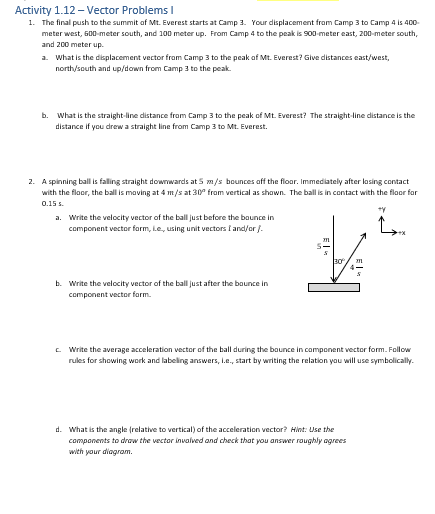Activity 1.12-Vector Problems I 1. The final push to the summit of Mt. Everest starts at Camp 3. Your displacement from Camp 3 to Camp 4 is 400- meter west, 600-meter south, and 100 meter up. From Camp 4 to the peak is 900-meter east, 200-meter south, and 200 meter up. a. What is the displacement vector from Camp 3 to the peak of Mt. Everest? Give distances east/west, north/south and up/down from Camp 3 to the peak. b. What is the straight-line distance from Camp 3 to the peak of Mt. Everest? The straight-line distance is the distance if you drew a straight line from Camp 3 to Mt. Everest. 2. A spinning ball is falling straight downwards at 5 m/s bounces off the floor. Immediately after losing contact with the floor, the ball is moving at 4 m/s at 30° from vertical as shown. The ball is in contact with the floor for 015
Activity 1.12-Vector Problems I 1. The final push to the summit of Mt. Everest starts at Camp 3. Your displacement from Camp 3 to Camp 4 is 400- meter west, 600-meter south, and 100 meter up. From Camp 4 to the peak is 900-meter east, 200-meter south, and 200 meter up. a. What is the displacement vector from Camp 3 to the peak of Mt. Everest? Give distances east/west, north/south and up/down from Camp 3 to the peak. b. What is the straight-line distance from Camp 3 to the peak of Mt. Everest? The straight-line distance is the distance if you drew a straight line from Camp 3 to Mt. Everest. 2. A spinning ball is falling straight downwards at 5 m/s bounces off the floor. Immediately after losing contact with the floor, the ball is moving at 4 m/s at 30° from vertical as shown. The ball is in contact with the floor for 015
University Physics Volume 1
18th Edition
ISBN:9781938168277
Author:William Moebs, Samuel J. Ling, Jeff Sanny
Publisher:William Moebs, Samuel J. Ling, Jeff Sanny
Chapter2: Vectors
Section: Chapter Questions
Problem 54P: A delivery man starts at the post office, drives 40 km north, then 20 km west, then 60 km northeast,...
Related questions
Question

Transcribed Image Text:Activity 1.12- Vector Problems I
1. The final push to the summit of Mt. Everest starts at Camp 3. Your displacement from Camp 3 to Camp 4 is 400-
meter west, 600-meter south, and 100 meter up. From Camp 4 to the peak is 900-meter east, 200-meter south,
and 200 meter up.
a. What is the displacement vector from Camp 3 to the peak of Mt. Everest? Give distances east/west,
north/south and up/down from Camp 3 to the peak.
b. What is the straight-line distance from Camp 3 to the peak of Mt. Everest? The straight-line distance is the
distance if you drew a straight line from Camp 3 to Mt. Everest.
2. A spinning ball is falling straight downwards at 5 m/s bounces off the floor. Immediately after losing contact
with the floor, the ball is moving at 4 m/s at 30° from vertical as shown. The ball is in contact with the floor for
0.15
a. Write the velocity vector of the ball just before the bounce in
component vector form, ie, using unit vectors I and/or /.
b. Write the velocity vector of the ball just after the bounce in
component vector form.
m
5
30
ty
L
Write the average acceleration vector of the ball during the bounce in component vector form. Follow
rules for showing work and labeling answers, i.e., start by writing the relation you will use symbolically.
d. What is the angle (relative to vertical) of the acceleration vector? Hint: Use the
components to draw the vector involved and check that you answer roughly agrees
with your diagram.
Expert Solution
This question has been solved!
Explore an expertly crafted, step-by-step solution for a thorough understanding of key concepts.
This is a popular solution!
Trending now
This is a popular solution!
Step by step
Solved in 4 steps with 4 images

Knowledge Booster
Learn more about
Need a deep-dive on the concept behind this application? Look no further. Learn more about this topic, physics and related others by exploring similar questions and additional content below.Recommended textbooks for you

University Physics Volume 1
Physics
ISBN:
9781938168277
Author:
William Moebs, Samuel J. Ling, Jeff Sanny
Publisher:
OpenStax - Rice University

Principles of Physics: A Calculus-Based Text
Physics
ISBN:
9781133104261
Author:
Raymond A. Serway, John W. Jewett
Publisher:
Cengage Learning

University Physics Volume 1
Physics
ISBN:
9781938168277
Author:
William Moebs, Samuel J. Ling, Jeff Sanny
Publisher:
OpenStax - Rice University

Principles of Physics: A Calculus-Based Text
Physics
ISBN:
9781133104261
Author:
Raymond A. Serway, John W. Jewett
Publisher:
Cengage Learning